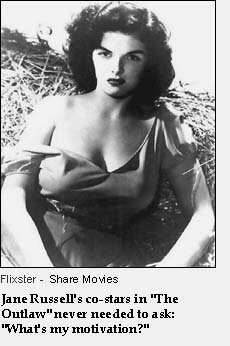


|
O-U-T also out Adjective, e.g., An O-U-T shot can range from the spectacular to T&A. Definition: Labels a shot or scene as extraneous to a movie’s narrative.
The term soon came to signify not only T&A, but what leading filmmakers considered Hughes’ real sin: including shots extraneous to a film’s narrative. However, the problem with O-U-T shots is that filmmakers disagree over whether a shot should be in or out. Even Howard Hughes argued that because “The Outlaw” was about Doc Holiday (John Huston) and Billy the Kid (Jack Buetel) feuding over Rio McDonald (Jane Russell), Rio's boobs loomed large in character motivation. On a higher plane, directors and cinematographers hotly debated (and continue to debate even though the film’s director won the Oscar) the relevance of a 5 ½ minute tracking shot in “Atonement” (2007) that critics claim causes viewers to lose track of the film’s story. Still, most O-U-T shots are of the “Night of the Sharks” (1987) vintage. In this Treat Williams thriller, a Mexican town is generically depicted by a montage of tile-roofed adobe houses, the bell tower of an adobe church, a cobble-stone town square and a garden with topless women. Related Terms: 18-wheeler establishing shot 30 Degree Rule Roddy's face-in-the-face worm hole |
 History: A term inspired by “The Outlaw” (1943), a movie directed and produced by Howard Hughes and starring Jane Russell. Hughes was less focused on his narrative than he was on Ms. Russell’s bust and even designed a cantilevered bra to better showcase it. The Hollywood Production Code Board would later order 30 seconds of Howard's shots out or, to quote censor Joe Breen, “O-U-T!”
History: A term inspired by “The Outlaw” (1943), a movie directed and produced by Howard Hughes and starring Jane Russell. Hughes was less focused on his narrative than he was on Ms. Russell’s bust and even designed a cantilevered bra to better showcase it. The Hollywood Production Code Board would later order 30 seconds of Howard's shots out or, to quote censor Joe Breen, “O-U-T!”